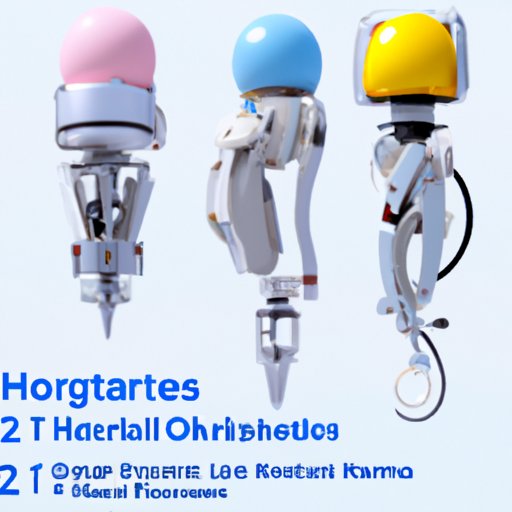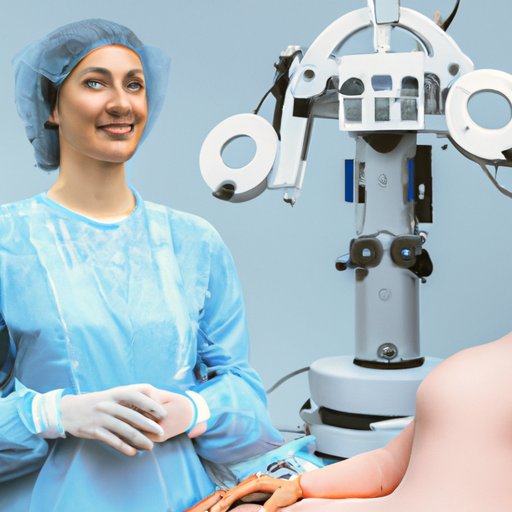Introduction
A robotic hysterectomy is a minimally-invasive surgical procedure that is used to remove the uterus and other reproductive organs. It is often performed to treat conditions such as uterine fibroids, endometriosis, abnormal bleeding, and certain types of gynecological cancers. In a robotic hysterectomy, a surgeon uses a robotic arm to perform the procedure, allowing for precise and accurate results. This article will discuss the different types of robotic hysterectomies, the benefits compared to traditional hysterectomies, what patients should know before deciding on a robotic hysterectomy, and potential risks and recovery processes associated with the procedure.

Explaining the Procedure: A Guide to Robotic Hysterectomy
Robotic hysterectomy is a form of minimally-invasive surgery that uses a robotic arm to perform the procedure. The robot is controlled by a surgeon who is sitting at a console several feet away from the patient. The robot’s arm is equipped with a camera and surgical instruments that allow the surgeon to perform the procedure with greater accuracy and precision than traditional open or laparoscopic hysterectomies.
What is a Robotic Hysterectomy?
The purpose of a robotic hysterectomy is to remove the uterus and other reproductive organs. This procedure can be used to treat conditions such as uterine fibroids, endometriosis, abnormal bleeding, and certain types of gynecological cancers. As with any surgery, there are risks involved with a robotic hysterectomy. It is important to discuss these risks with your doctor before undergoing the procedure.

Different Types of Robotic Hysterectomies
There are three main types of robotic hysterectomies: total, subtotal, and radical. In a total hysterectomy, the entire uterus and cervix are removed. In a subtotal hysterectomy, only the uterus is removed, leaving the cervix intact. In a radical hysterectomy, the uterus, cervix, and surrounding tissue are removed.
Benefits of a Robotic Hysterectomy
Robotic hysterectomies offer a number of benefits compared to traditional open or laparoscopic hysterectomies. These benefits include reduced pain and recovery time, improved accuracy and precision, and reduced risk of complications.
The Benefits of a Robotic Hysterectomy Compared to Other Options
Robotic hysterectomy offers many advantages over traditional open or laparoscopic hysterectomy. For one, it is less invasive, resulting in a shorter hospital stay and quicker recovery time. Additionally, robotic hysterectomy is more precise and accurate due to the use of the robotic arm and its related technology. This increases the chances of successful treatment, while reducing the risk of complications and side effects.

How a Robotic Hysterectomy Can Improve Quality of Life
Robotic hysterectomy can improve quality of life in several ways. First, it reduces pain and recovery time, allowing patients to return to their normal activities sooner. Second, it gives patients more control over their decision-making, as they can choose the best course of treatment for their situation. Finally, it can reduce the risk of long-term health issues associated with traditional open or laparoscopic hysterectomies.
What Patients Should Know Before Deciding on a Robotic Hysterectomy
Before deciding on a robotic hysterectomy, it is important for patients to understand the risks involved. They should also consult with their doctor to ensure that the procedure is right for them. Additionally, patients should prepare for the procedure by following pre-operative instructions given by their doctor.
Common Questions About Robotic Hysterectomy
Patients may have questions about robotic hysterectomy, such as who is eligible for the procedure, what are the side effects, and what is the recovery process like. Generally, anyone who needs a hysterectomy is eligible for a robotic hysterectomy, although it is important to speak to your doctor to make sure it is the best option for you. Common side effects include pain, bloating, and cramping, which typically resolve within a few days. The recovery process varies depending on the individual, but generally involves rest, avoiding strenuous activities, and taking medications as prescribed.

Understanding the Risks and Recovery After a Robotic Hysterectomy
As with any surgical procedure, there are potential risks associated with robotic hysterectomy. These include infection, bleeding, and damage to surrounding organs. It is important to discuss these risks with your doctor before undergoing the procedure. Recovery time after a robotic hysterectomy varies depending on the individual, but generally takes two to four weeks. During this time, it is important to follow your doctor’s instructions for a successful recovery, including resting, avoiding strenuous activities, and taking medications as prescribed.
Conclusion
Robotic hysterectomy is a minimally-invasive surgical procedure that can be used to treat a variety of conditions. It offers a number of benefits compared to traditional open or laparoscopic hysterectomies, including reduced pain and recovery time, improved accuracy and precision, and reduced risk of complications. Patients should understand the risks and recovery process before deciding on a robotic hysterectomy, and should consult with their doctor to ensure that it is the best option for them. Ultimately, robotic hysterectomy can improve quality of life by providing a quicker recovery and more control over decision-making.
(Note: Is this article not meeting your expectations? Do you have knowledge or insights to share? Unlock new opportunities and expand your reach by joining our authors team. Click Registration to join us and share your expertise with our readers.)
